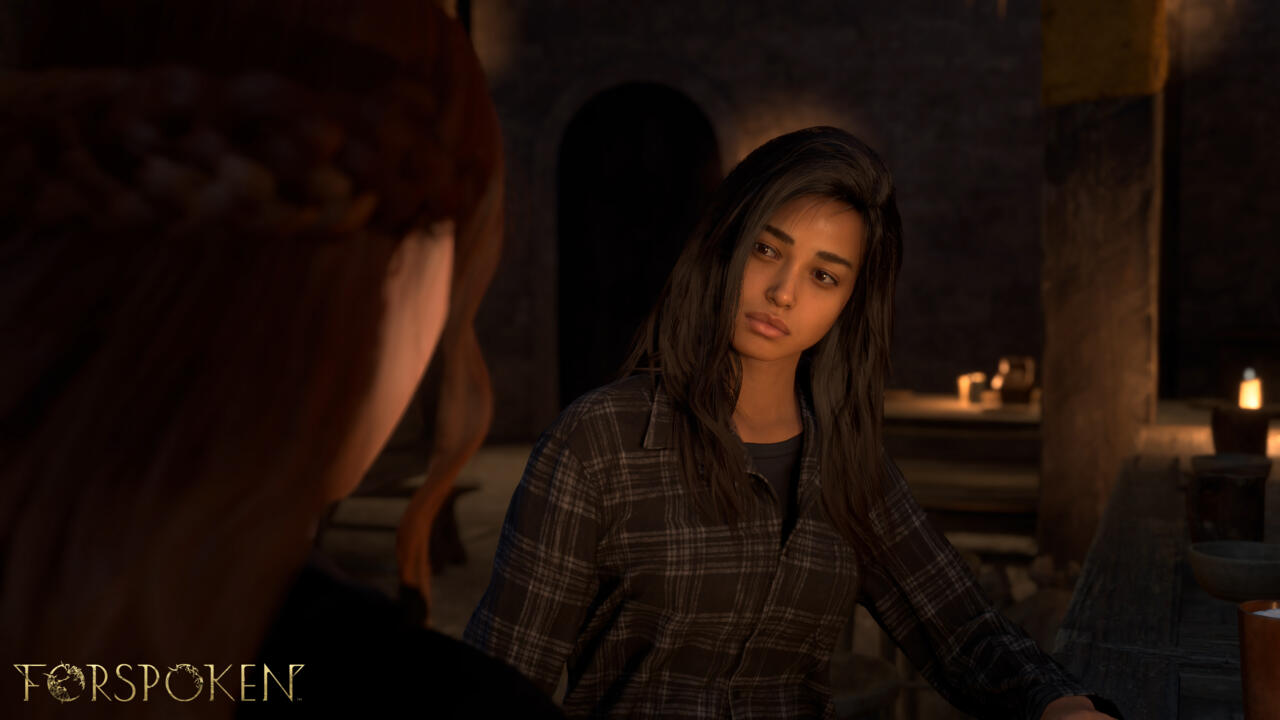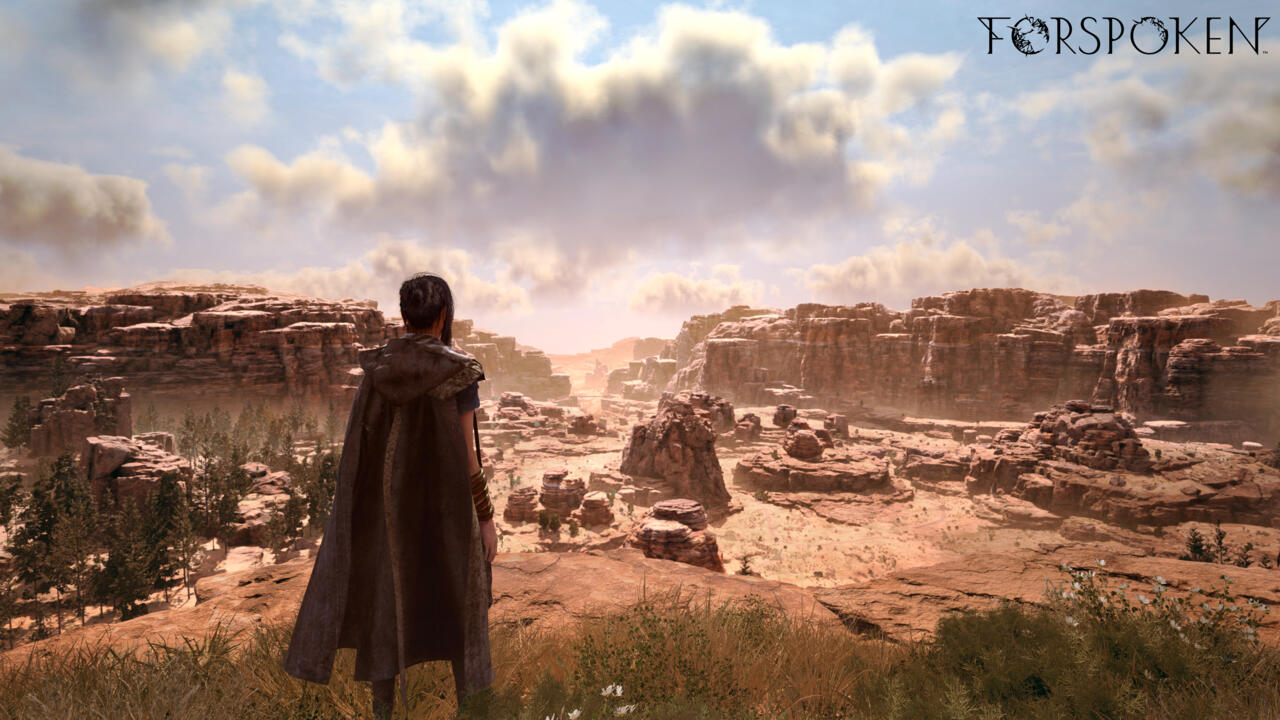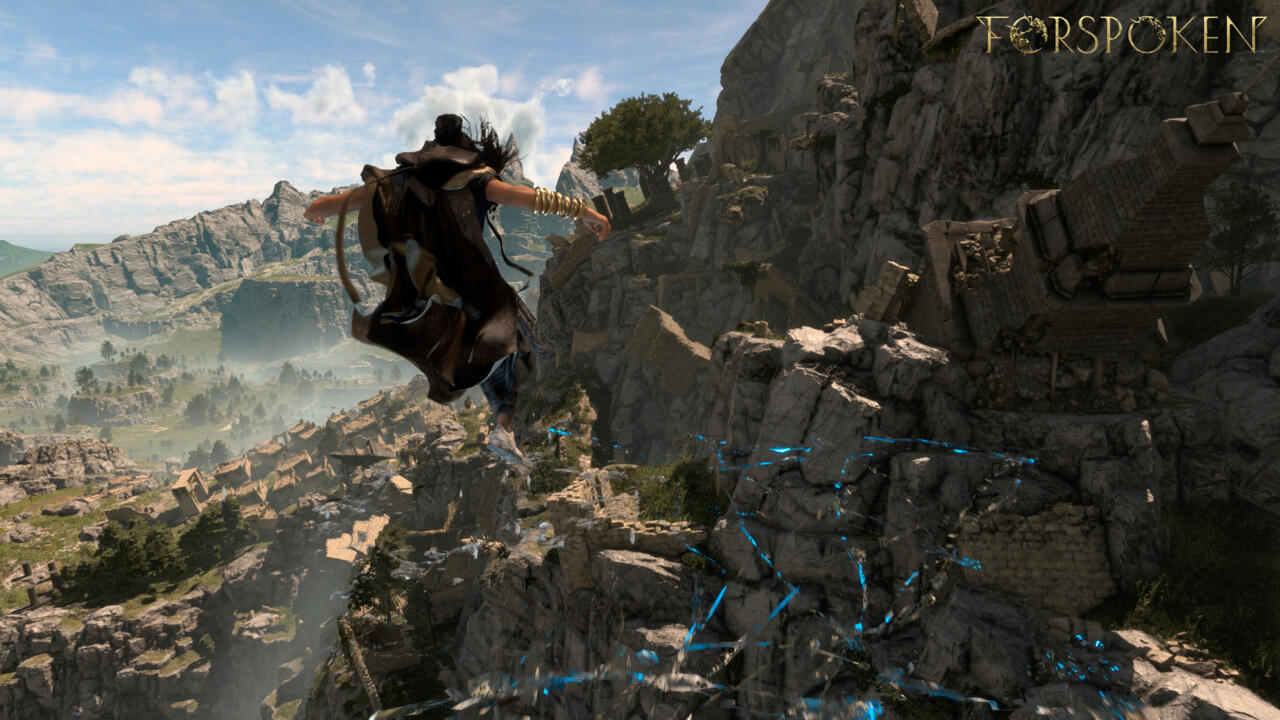My first impression of Forspoken upon watching its reveal trailer was genuine glee. Seeing a Japanese-developed role-playing game with a dark-skinned person of color as the main protagonist is rare. Seeing such a game starring a Black woman is exceptionally rare. Learning later that a vast majority of the principal cast are women is practically unheard of.
So I went into this latest hands-off press preview of Forspoken with hopeful expectations. And, at first, it seemed like developer Luminous Productions and publisher Square Enix knew their stuff. Going into this game, Forspoken creative producer Raio Mitsuno wanted this to be an experience that primarily featured a female cast and starred a protagonist that broke free of conventional fantasy hero tropes--everything else about the game was built around that concept "from the beginning of the project."
"That was really one of the core concepts that we had from the very beginning of the game--we wanted to create a world with a bunch of strong female characters, and we wanted a world of magic," Mitsuno told me. "And we wanted to use those as our pillars when we started the project. We were impressed with the increasing number of female leads in the industry, but we wanted to really take it a step further and go with a female-centric world. We also wanted--with our main character Frey--to portray a character who was really down-to-earth and a realistic portrayal of a modern-day young woman, who just so happens to then get thrown into this world with a bunch of powerful women, a sort of matriarchal society."
In Forspoken, you play as Frey Holland, a young New Yorker who has hit rock bottom in her life and desperately yearns to get out of the city and find a place where she can belong. She sort of gets her wish when a strange portal suddenly transports her to the fantastical world of Athia, where she meets a sentient bracelet named Cuff. She eventually befriends the people of Cipal, the last surviving human city on Athia, which is only spared by the growing miasma (called the Break) blanketing the land by existing on a mountaintop. Frey sets off in search of a way home, learning she's capable of extremely powerful magic along the way, which aids her in both traversal and combat.
"We are not following the typical hero approach with Frey," Mitsuno said. "You'll see really early on that she's a very incomplete person. There's a lot going on in her life. You'll see how vulnerable she is, as [lead writers Todd Stashwick and Allison Rymer] mentioned, she puts up a tough façade with her humor--she tries to protect herself, and doesn't like to show weakness. So we have a character that is very raw, and feels very real. And we see her go through a lot of stuff in this game, and she eventually grows and matures as a person."
In a presentation, Stashwick told the press that Frey is looking for her "family" or "tribe." It's a set-up that reminds me a lot of isekai, a Japanese genre of light novels, manga, anime, and games where the protagonist is transported to and becomes trapped in another world. Less so modern-day isekai, which are largely harem-focused male power fantasies, and more so '90s and early 2000s isekai, where female protagonists and mixed-gendered hero groups dominated the genre and the stories focused on achieving personal power and agency by finding self-confidence and overcoming doubts and insecurities. So The Vision of Escaflowne and Digimon Adventure vibes, not Sword Art Online or Overlord.
Those are vibes that I find intriguing, but I am worried about how well the game can capture the experience of a Black woman in that storyline. In terms of writing talent, the studio has that on lock. Both Gary Whitta (co-writer for Rogue One: A Star Wars Story, writer and consultant for The Walking Dead: The Final Season) and Amy Hennig (head writer and creative director for the first three Uncharted games) created the bedrock for Forspoken's story, with Whitta responsible for developing the concept of the world and Hennig focusing on the narrative and how it fit into the design of the game. From there, Rymer and Stashwich took over, writing the final story and script. The issue that gives me pause is that none of those people are Black, so as good as the story may be, the preview left me with misgivings about the writing for its protagonist.
In response, Luminous Productions development team told GameSpot that writers and voice talent were both instrumental in the development of Frey's character (Frey is both voiced by and modeled after actor Ella Balinska). "Balinska has been fantastic to work with--she immediately connected with Frey as a character and has been incredibly passionate about getting her portrayal in the game right, providing invaluable feedback throughout the motion and VO capture process," Luminous Productions said in a response statement. "Additionally, we worked closely with a number of consultants from BIPOC backgrounds to help portray Frey's character and tell the story from her perspective."

All in all, it sounds like the team has done the homework, but I'm still left a little concerned over the lack of melanin in Forspoken's writers room. I will be thrilled if I see I'm worrying about nothing once Forspoken launches, but for now I'm remaining cautious.
For those curious as to whether Forspoken's gameplay is any fun, I'm not sure what to tell you. Previews only ever give us a small sample of what a game is, and it's even harder to make a judgement call when you're only watching a recording of someone else playing and can't even get a sense of how it all feels. Is zipping through the environment with a flurry of parkour moves as satisfying as it looks? Maybe. Are the variety of spell combinations you can pull off as rewarding to do as they appear? Gosh, I hope so.
I can say that my first impression of the world of Athia is mixed. The act of exploring looks fun with how quickly and efficiently Frey flips and hops through the environment like a magical Spider-Woman. Movement is stylish and fluid, with the world speeding past you at a seemingly gratifying pace--and Frey appears to possess abilities that will allow her to navigate Athia on both horizontal and vertical planes, which means there could be a nice verticality to combat as well.
But the world itself seems empty of meaningful things to go find and do, beyond fighting different enemies. In a statement, Luminous Productions said that "there are still plenty of things for players to discover organically if they venture off the beaten path," but I saw no clear example of that during the presentation.

If the preview was any indication, it sounds like the main crux of what players will experience when exploring the open world is near-constant chatter between Frey and Cuff. "Overall, the state of Athia does fit the tone of a darker, grittier fantasy world," Mitsuno said. "But we balance that with a lot of colorful commentary and playful banter between Frey and Cuff--they try to make sarcastic comments about the situations they're in. So it's balanced with a little bit of that comedic tone, but overall, you're in a very serious and very dark situation."
Other open world games have used banter between their characters to fill the void while exploring between story missions--Saints Row IV, Sunset Overdrive, Marvel's Spider-Man, and Deathloop, just to name a few--but I am still worried by just how empty Athia looks. Banter and enjoyable movement can only propel an open world so far. I think the idea of Cipal being the last safe haven sounds cool on paper, but in practice it results in a world that looks devoid of life as soon as you leave the hub area.
"Overall, the world and setting revolves around the fact that Cipal is the last remaining city," Forspoken co-director Takefumi Terada told me. "And so anything outside of that city is barren and already collapsed because the world is heading towards corruption."
In the preview I saw, Frey and Cuff do find the ruins of where humanity once lived. Frey can even use some of those places as safe houses to rest and regain health. This seems to be the extent of non-aggressive life that you find outside of Cipal though, as Terada said that you'll only see "remnants of humanity through your exploration."

Admittedly, this does create a narrative development that I am intrigued to see unfold in Forspoken's story. Athia is so devoid of life because the Break transforms every living thing that comes in contact with it into a terrifying monster, regardless of what that creature was originally. So Frey's ability to safely move within the Break puts her at odds with those who live in Cipal--they view her as a demon who's not to be trusted. Ironically, her ability to navigate the Break means she's also the only person ideally suited to exploring it, finding its root cause, and stopping it. So alongside her quest to get home, Frey is also roped into aiding people who don't want anything to do with her. I didn't get a chance to see how that dynamic could play out, but it at least sounds intriguing, as it sets up the world of Athia where Frey is outwardly attacked by monsters whenever she ventures outside Cipal and mentally and emotionally attacked by her own insecurities and societal stigma when within the city. Those are two totally different conflicts for the game to possibly explore, and if it does, I wonder which of the two will Frey handle better.
All in all, Forspoken looks like a pretty game. It looks like an experience where navigation and combat mechanics flow together and you're able to pull off bombastic combos with seemingly hard-hitting attacks that explode with a display of colorful carnage. Forspoken looks like a game where you return to a hub city and regularly venture out into a world that appears to be shockingly devoid of anything meaningful to do but flip through the air and fight enemies. Problem is, I've seen all those things come together in a game before, and BioWare's Anthem didn't turn out so well. I'm hoping I'm wrong, and that Frey's characterization propels Forspoken's campaign forward, but it's hard to tell how this game will play and whether it's good without actually getting hands on with it. We're still a ways from that too, as Forspoken is planned to launch for PS5 and PC on May 24.

